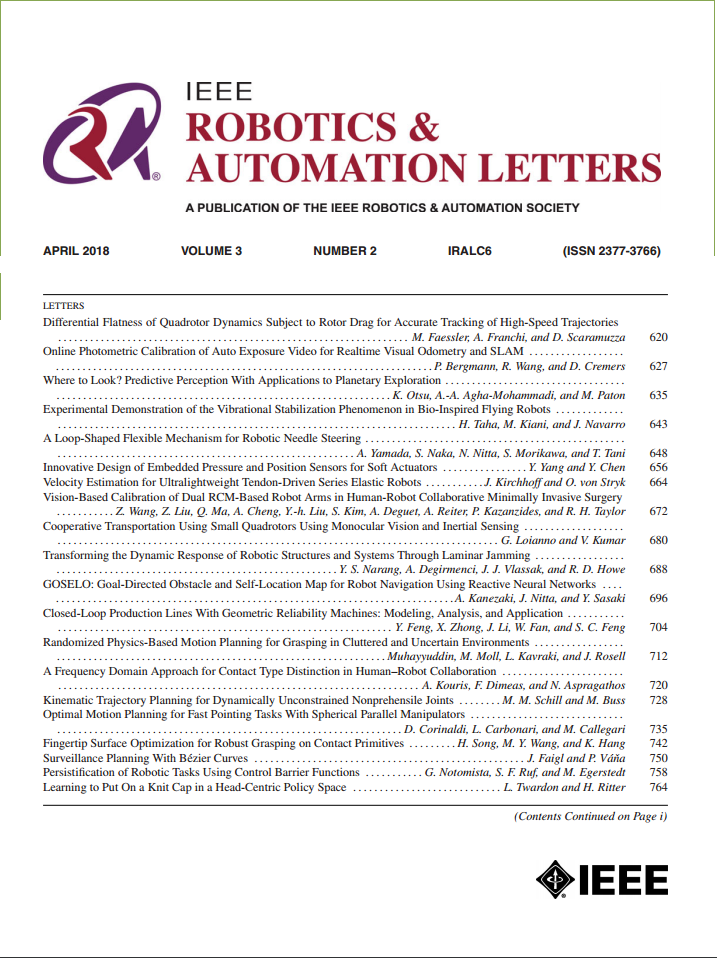Estimation of Gait Phase of Human Stair Descent Walking Based on Phase Variable Approach
IF 5.3
2区 计算机科学
Q2 ROBOTICS
引用次数: 0
Abstract
Synchronization between a wearer and a lower limb powered prosthesis is important for effective control. Typically, phase variable-based phase estimation methods are employed. However, there is a noticeable lack of studies focusing on estimating the gait phase during stair descent, likely due to the difficulty in generating a reliable phase variable. In most studies, the thigh angle is used to generate phase variables for level walking because it follows a sinusoidal pattern. However, during stair descent, the thigh angle exhibits only a partially sinusoidal shape, making it challenging to apply the methods used for level walking. In this study, we propose a novel phase variable generation method to address the difficulty of using only the thigh angle for stair descent. To estimate the gait phase reliably, the phase variable is defined differently for the stance and swing phases: the hip position is used to generate the phase variable during the stance phase, and the thigh angle is used during the swing phase. These phase variables are then unified into a single phase variable (PV-ENT) for the entire gait cycle of stair descent. During this unification process, a non-smooth transition occurs around the phase transition point. To address this, a blending method is applied. The proposed method was validated using the data from 12 healthy subjects, collected through a motion capture system and IMU sensors. The results demonstrate a reliable phase estimation performance. Moreover, the blending method successfully improves the smoothness of the phase variable around the phase transition point without reducing the overall phase estimation performance.基于相位变量法的人下楼梯步态相位估计
佩戴者与下肢动力假体之间的同步对于有效控制非常重要。通常采用基于相位变量的相位估计方法。然而,由于难以生成可靠的相位变量,在楼梯下降过程中步态相位估计方面的研究明显缺乏。在大多数研究中,大腿角度被用来生成水平行走的相位变量,因为它遵循正弦模式。然而,在楼梯下降过程中,大腿角度仅呈现部分正弦形状,这使得应用水平行走的方法具有挑战性。在这项研究中,我们提出了一种新的相位变量生成方法,以解决仅使用大腿角度进行楼梯下降的困难。为了可靠地估计步态相位,在站立阶段和摇摆阶段对相位变量进行了不同的定义:在站立阶段使用臀部位置生成相位变量,在摇摆阶段使用大腿角度生成相位变量。然后将这些相位变量统一为一个单相变量(PV-ENT),用于下楼梯的整个步态周期。在这一统一过程中,在相变点附近发生了一个非平滑的转变。为了解决这个问题,应用了一个混合方法。通过运动捕捉系统和IMU传感器收集的12名健康受试者的数据验证了所提出的方法。结果表明,该方法具有可靠的相位估计性能。此外,该混合方法在不降低整体相位估计性能的情况下,成功地提高了相位变量在相变点周围的平滑度。
本文章由计算机程序翻译,如有差异,请以英文原文为准。
求助全文
约1分钟内获得全文
求助全文
来源期刊

IEEE Robotics and Automation Letters
Computer Science-Computer Science Applications
CiteScore
9.60
自引率
15.40%
发文量
1428
期刊介绍:
The scope of this journal is to publish peer-reviewed articles that provide a timely and concise account of innovative research ideas and application results, reporting significant theoretical findings and application case studies in areas of robotics and automation.
 求助内容:
求助内容: 应助结果提醒方式:
应助结果提醒方式:


